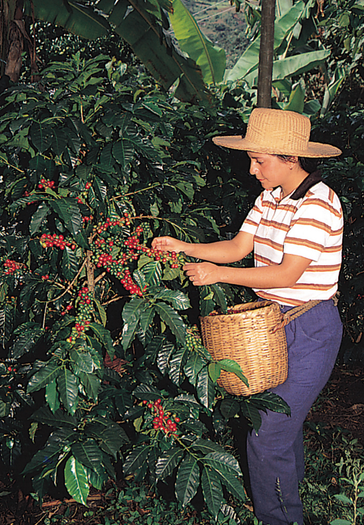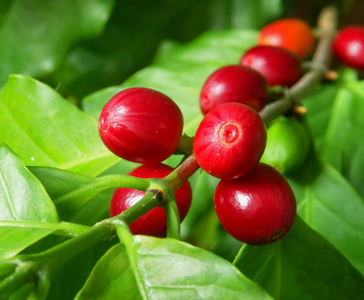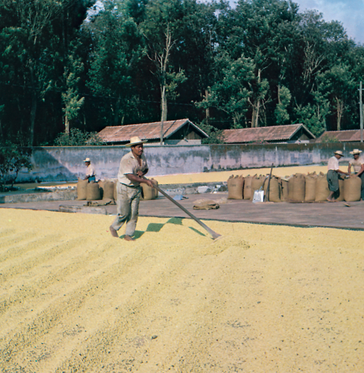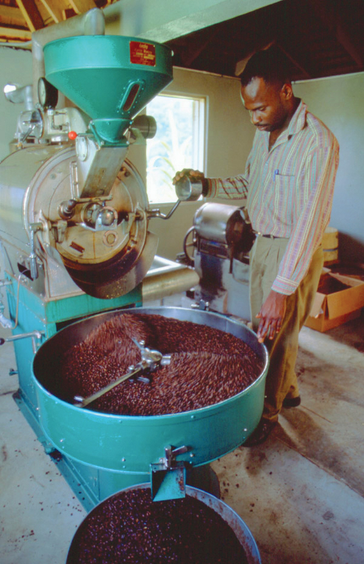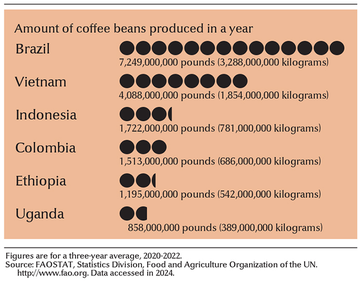Coffee is a drink made from the roasted and ground beans of the coffee plant. It is the favorite hot drink in almost every country in the world. The rich aroma of coffee adds much to the pleasure of drinking it. The coffee break has become an integral part of the business world.
The United States ranks as the largest consumer of coffee. Americans drink about 400 million cups every day. Each year, the United States consumes about 3 billion pounds (1.38 billion kilograms) or about one-sixth of all the coffee grown in the world. Other leading coffee-consuming countries include Brazil, Canada, France, Germany, Italy, Japan, the Philippines, and Russia. Austria, Denmark, Finland, Iceland, Luxembourg, Norway, and Sweden are among the leaders in coffee consumption per person. Brazil produces about one-third of the world's coffee crop. Coffee is vital to the economies of many developing countries.
From bean to cup
The coffee plant. About 70 percent of the world's coffee comes from the plant Coffea arabica, which originally grew wild in Ethiopia. It is now cultivated in Java, Sumatra, India, Arabia, equatorial Africa, Hawaii, Mexico, Central and South America, and the Caribbean.
Coffea arabica is a shrub with glossy, evergreen leaves. It is 14 to 20 feet (4.3 to 6.1 meters) high when fully grown. As a rule, coffee growers prune it to under 12 feet (3.7 meters). It has white flowers that are self-pollinating.
Another species of coffee plant, Coffea robusta, accounts for most of the rest of the world's coffee. Coffea robusta, produces smaller beans than Coffea arabica. The robusta plant grows at lower altitudes than arabica, and can be found in Africa and Southeast Asia.
The coffee fruit is called a berry. It begins to grow while the plant is blossoming and ripens from green to yellow to red. The average plant produces enough berries each year to make about 11/2 pounds (0.7 kilogram) of roasted coffee.
A coffee plant is usually six to eight years old before it bears a full crop of berries. The common variety of coffee plant grows best at altitudes that range from 3,600 to 8,000 feet (1,100 to 2,400 meters) in a tropical climate. The majority of coffee plants grow from seeds that are first planted in nursery beds. After a year in the nursery, the seedlings are transplanted to prepared fields. About 500 to 1,000 seedlings are planted per acre.
Preparation for market. Most berries are handpicked. However, some are harvested by machines that vibrate the berries off the trees. After the berries are picked, they are put through a bath of running water called a sluice. Sticks, leaves, and the green and bad berries float. The good berries sink to the bottom.
Pulping. The good berries then go to a pulping house, where machinery removes the pulp. Each berry contains two beans (seeds). Each bean has a thin parchmentlike skin and a second covering called the silver skin. At first, the uncovered beans appear soft and bluish-green. Later, they become hard and pale yellow.
Following the pulping process, the beans are run through fermenting and washing tanks. The beans are then dried and left to cure for several weeks.
Hulling and peeling make up the next step in the preparation of coffee for the market. Milling machines remove the parchment and the silver skin. As the beans come from the machine, a fan blows off the loose skins. The beans then go to a machine called the separator, which removes sand, dust, and small or broken beans. The beans are sorted until only the largest and best of the coffee beans remain.
Roasting. Most coffee is shipped in 132-pound (60-kilogram) burlap bags. At the roasting plant, the beans are emptied into chutes leading from an upper to a lower floor. An air-suction device removes dust and other materials from the coffee. The coffee then goes to the blending machine, a cylinder that mixes different types of coffee.
From the blender, the beans flow by gravity to storage bins, then to roaster ovens. There, the beans are roasted at 900 °F (482 °C) for 16 to 17 minutes. The beans lose about a sixth of their weight during roasting. The beans are then cooled and cleaned, and carried to bins where they are stored until ground. After being ground to drip, regular, or fine requirements, the coffee is packed in vacuum tins or in paper bags.
Instant coffee can be either powdered or freeze-dried. Both require adding water to make coffee.
Powdered instant coffee is made by brewing coffee in huge containers and evaporating the water from the brew. The remaining powder crystals become coffee again when water is added.
Freeze-dried instant coffee is made by converting freshly brewed coffee into an extract and freezing it in slabs. The slabs are ground into chunks and put in pressurized chambers. Moisture in the form of ice is drawn off, leaving dry coffee crystals.
A good cup of coffee. Best brewing results are obtained by using one standard coffee measure, or two level tablespoons, to each cup. The water should be freshly drawn from the cold-water tap. Most coffee is made in percolators, drip pots, or vacuum coffeemakers, which strain boiling water through the coffee.
Kinds of coffee
Coffee producers sell more than one hundred kinds of coffee. These kinds may be divided into three general groups—Brazils, Milds, and Robustas. The Milds include all Coffea arabica grown outside of Brazil. Most coffee is named for the region where it grows or the port from which it is shipped. Mocha is named for the port of Mocha (Al Mukha) in Yemen. Java grows in and near Java.
Roasters place great importance on the taste of their blends. Blends often include herbs and other additives. Chicory, for example, is an herb commonly added to coffee blends.
Coffee contains caffeine , a substance that acts as a stimulant on the nervous system). Some people find decaffeinated coffee more healthful. In most cases, the removal of caffeine from coffee is a cold-water extraction, which is done with the help of chemicals.
History
According to legend, coffee was discovered in Ethiopia when goatherds noticed that their flocks stayed awake all night after feeding on coffee leaves and berries. Coffee reached Arabia in the 1200's. Coffee comes from the Arabic word qahwah.
Before its use as a beverage 700 years ago, coffee was used as a food, then a wine, and then a medicine. Coffee moved from Arabia to Turkey during the 1500's, and to Italy in the early 1600's. Coffee houses sprang up throughout Europe in the 1600's, and people met there for serious discussions. Coffee probably came to America in the 1660's. Coffee growing was introduced in Brazil in the 1700's.
Coffee-exporting countries have tried for many years to control coffee prices and surpluses. At first, they agreed to export quotas that limited each country's exports. They also tried to control prices by stockpiling some coffee instead of exporting it. But in 1963, the United Nations helped arrange an International Coffee Agreement that included both exporting and importing countries. Countries that exported coffee accepted export quotas on coffee. Countries that imported coffee agreed to observe a floor on coffee prices and to limit their purchases of coffee from countries that did not sign the International Coffee Agreement. The agreement came to an end in 1989. Coffee prices have since fluctuated (risen and fallen) dramatically.
Beginning in the late 1900's, large chains of coffee shops developed in the United States and other countries. These chains resemble fast-food restaurants and sell a variety of gourmet coffees.

